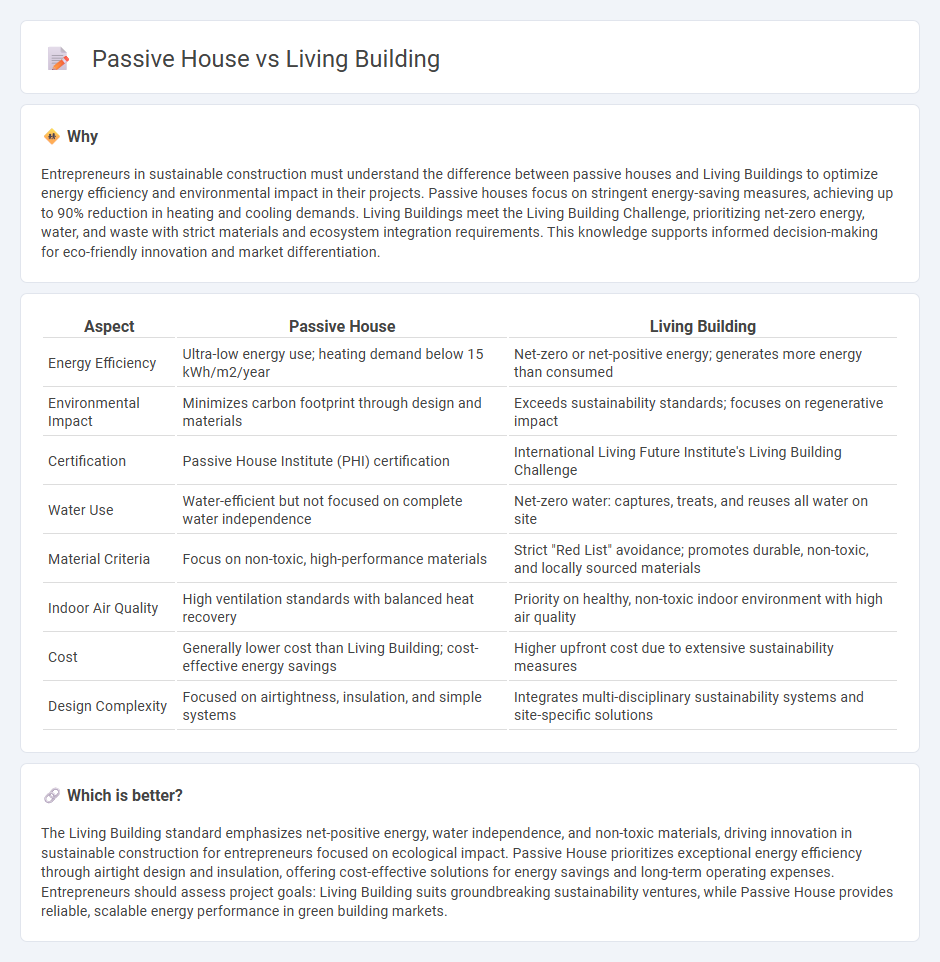
Entrepreneurship in sustainable construction thrives through innovative models like Passive House and Living Building standards, each emphasizing energy efficiency and environmental responsibility. Passive House focuses on superior insulation and airtight design to minimize energy consumption, while Living Building integrates regenerative design principles to achieve net-positive energy and water usage. Explore how these pioneering frameworks shape the future of eco-friendly entrepreneurship and construction practices.
Why it is important
Entrepreneurs in sustainable construction must understand the difference between passive houses and Living Buildings to optimize energy efficiency and environmental impact in their projects. Passive houses focus on stringent energy-saving measures, achieving up to 90% reduction in heating and cooling demands. Living Buildings meet the Living Building Challenge, prioritizing net-zero energy, water, and waste with strict materials and ecosystem integration requirements. This knowledge supports informed decision-making for eco-friendly innovation and market differentiation.
Comparison Table
| Aspect | Passive House | Living Building |
|---|---|---|
| Energy Efficiency | Ultra-low energy use; heating demand below 15 kWh/m2/year | Net-zero or net-positive energy; generates more energy than consumed |
| Environmental Impact | Minimizes carbon footprint through design and materials | Exceeds sustainability standards; focuses on regenerative impact |
| Certification | Passive House Institute (PHI) certification | International Living Future Institute's Living Building Challenge |
| Water Use | Water-efficient but not focused on complete water independence | Net-zero water: captures, treats, and reuses all water on site |
| Material Criteria | Focus on non-toxic, high-performance materials | Strict "Red List" avoidance; promotes durable, non-toxic, and locally sourced materials |
| Indoor Air Quality | High ventilation standards with balanced heat recovery | Priority on healthy, non-toxic indoor environment with high air quality |
| Cost | Generally lower cost than Living Building; cost-effective energy savings | Higher upfront cost due to extensive sustainability measures |
| Design Complexity | Focused on airtightness, insulation, and simple systems | Integrates multi-disciplinary sustainability systems and site-specific solutions |
Which is better?
The Living Building standard emphasizes net-positive energy, water independence, and non-toxic materials, driving innovation in sustainable construction for entrepreneurs focused on ecological impact. Passive House prioritizes exceptional energy efficiency through airtight design and insulation, offering cost-effective solutions for energy savings and long-term operating expenses. Entrepreneurs should assess project goals: Living Building suits groundbreaking sustainability ventures, while Passive House provides reliable, scalable energy performance in green building markets.
Connection
Entrepreneurship drives innovation in sustainable building by integrating Passive House and Living Building standards, promoting energy efficiency and net-zero environmental impact. Startups focusing on green construction harness these rigorous frameworks to develop market-leading solutions that reduce carbon footprints and operational costs. Investment in such eco-friendly ventures aligns with growing consumer demand for resilient, health-conscious buildings, fostering a new wave of sustainable business models.
Key Terms
Energy Efficiency
Living Buildings achieve net-zero energy by integrating renewable energy systems like solar panels, emphasizing on-site energy generation and ecological harmony. Passive Houses prioritize energy efficiency through superior insulation, airtight construction, and heat recovery ventilation, substantially reducing heating and cooling demands. Explore the advanced energy-saving features of each standard to determine the best fit for sustainable living.
Sustainability Standards
Living Buildings adhere to the rigorous Living Building Challenge, emphasizing net-zero energy, water, and waste, alongside stringent material transparency and social equity criteria. Passive Houses prioritize ultra-high energy efficiency through superior insulation, airtightness, and passive solar design, drastically reducing heating and cooling demands. Explore detailed comparisons to understand how these sustainability standards shape future green building practices.
Certification Systems
Living Building Challenge certification demands rigorous performance across energy, water, and health criteria, emphasizing net-positive energy and water systems. Passive House certification prioritizes achieving superior energy efficiency through strict standards on thermal insulation, airtightness, and minimal energy consumption, often verified by blower door tests. Explore detailed criteria and comparisons to determine the ideal green building certification for your project.
Source and External Links
So, what exactly is a 'living building'? | Yale News - A living building is one that makes positive contributions to its broader ecology throughout its existence, taking full responsibility for all inputs and outputs, exemplified by Yale's Living Village project meeting the Living Building Challenge standards.
Living Building Challenge - Wikipedia - The Living Building Challenge is a 2006 international sustainable building certification program promoting comprehensive sustainability in the built environment, managed by the International Living Future Institute and distinct from other green certifications.
Living Building Challenge - This challenge is a certification, philosophy, and advocacy tool defining the highest sustainability standards for regenerative, self-sufficient buildings that positively impact human and natural systems across all scales of design and construction.
 dowidth.com
dowidth.com